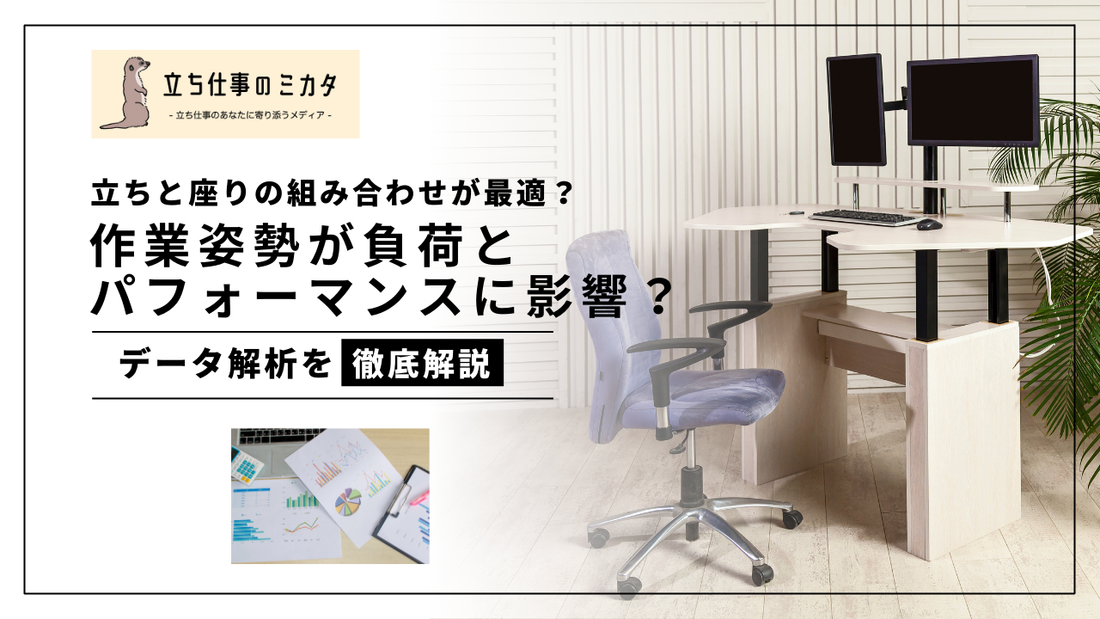
Is a combination of standing and sitting optimal? Research into the effects of work posture on physical strain and work performance
Share
Introduction
The impact of working posture on labor productivity and fatigue is an important factor in designing the workplace. In this article, we will explain how alternating between standing and sitting positions affects work efficiency and strain, based on a study on the effect of combining working postures in short-term simple repetitive tasks .
Research Overview
In this study, we investigated the effects of different postures on work load and performance when performing light work . Eight male subjects were asked to perform a 60-minute task (solving single-digit multiplication problems and typing the answers into a keyboard) under the following experimental conditions.

| Experimental conditions | Posture 1 | Posture 2 | Posture 3 |
|---|---|---|---|
| Condition 1 | Sitting position 30 minutes |
Standing for 30 minutes | – |
| Condition 2 | Standing for 30 minutes | Sitting position 30 minutes | – |
| Condition 3 | Sitting position 15 minutes | Standing for 30 minutes | Sitting position 15 minutes |
| Condition 4 | Standing for 15 minutes | Sitting position 30 minutes | Standing for 15 minutes |
| Condition 5 | Sitting position 60 minutes | – | – |
| Condition 6 | Standing for 60 minutes | – | – |
In this experiment, the following indicators were used for evaluation: **Work load (subjective assessment of fatigue and physiological measurements), work efficiency (correct answer rate), and secondary behaviors (movements such as yawning and moving one's head)**.
The relationship between work posture and work performance
The results of this study revealed the following:
1. If you don't change your work posture, your work performance will decrease.
In conditions where participants remained in either a sitting or standing position for 60 minutes (conditions 5 and 6), the rate of incorrect answers increased and task performance declined . This is thought to be because maintaining a single posture for a long period of time reduces concentration and causes fatigue.

2. Changing posture every 15 or 45 minutes is best
When combining sitting and standing, the task performance improved the most when the first posture change was made after 15 minutes and the second change after 45 minutes (conditions 3 and 4). This is thought to be because changing posture at the appropriate times prevents monotony and reduces fatigue.

3. Continuously standing upright is a big burden
When subjects continued standing for 60 minutes (condition 6), it became clear that fatigue was likely to accumulate, especially in the lower back and lower limbs . It has been suggested that fatigue increases secondary behaviors (yawning, shaking legs, touching parts of the body, etc.), leading to a decrease in concentration.

Benefits of changing your working posture
Properly changing your working posture has the following benefits:
✅ Reduce fatigue
- Changing your posture improves blood flow and distributes the strain on your muscles.
- In particular, the burden on the lower back and lower limbs is reduced.
✅ Improved work performance
- It reduces the monotony caused by staying in the same position for a long period of time and helps maintain concentration.
- Changing posture every 15 or 45 minutes improves work efficiency the most.
✅ Optimizing the Workplace
- By combining appropriate postures for each task, employee fatigue can be reduced and productivity improved.
- Alternating between standing and sitting can reduce long-term health risks.
Practical Recommendations
Based on these research results, we propose measures that should be implemented in workplaces where simple, short-term tasks are performed .
1. Choose the right posture for each task
- **Standing is suitable for dynamic tasks (moving and assembling objects).**
- **A sitting position is suitable for work that requires concentration (detailed work, data entry)**
2. Introduce posture changes every 15 to 30 minutes
- It is recommended to change posture every 15 and 45 minutes during a 60-minute work session.
- If possible, taking time to walk can help reduce fatigue even further.
3. Prepare your work environment
- Adjust the height of your workbench and chair so that you can work comfortably whether you are standing or sitting.
- Anti-fatigue mats will be installed to reduce the strain of standing.
Conclusion
This study clarified that an appropriate combination of sitting and standing positions is effective in improving work performance and reducing fatigue . In particular, it was suggested that changing posture every 15 minutes and 45 minutes was the most effective method.
It is important to adopt an appropriate combination of working postures in order to maximise work efficiency and protect employee health in the workplace.

